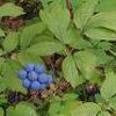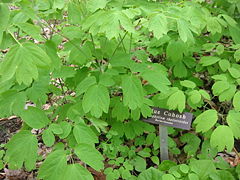[Caulophylum thalictroides]
Blue Cohosh:
Blue Cohosh – Herbal labor inducer
Warning: No one with high blood pressure, heart disease, diabetes, glaucoma, or a history of stroke should use blue cohosh.
—Botanical name— Caulophylum thalictroides
—Chinese Botanical name—
This information clearly states that Blue Cohosh does have benefit.
—Description— Labor inducer, Menstruation promotion, Intriguing possibilities. #
Blue cohosh is used for stimulating the uterus and starting labor; starting menstruation; stopping muscle spasms; as a laxative; and for treating colic, sore throat, cramps, hiccups, epilepsy, hysterics, inflammation of the uterus, infection of the female organs (pelvic inflammatory disease), over-growth of uterine.
—Family— Berberidaceae; other members include – May apple, Mandrake, and Barberry.
— Synonyms— Papoose root and blue berry.
—Parts Used— Root.
—Constituents— Caulosaponin
—Medicinal Action and Uses—Blue cohosh’s traditional uses in gynecology appear to stand up to scientific scrutiny.
· LABOR INDUCER – Researchers have discovered a chemical (caulosaponin) in blue Cohosh that provokes strong uterine contractions, thus supporting its primary Indian use. #
However, caulosaponin also narrows the arteries that supply blood to the heart. Blue Cohosh has produced heart damage in laboratory animals, and human heart damage seems quite possible from overdose.
On the other hand, blue Cohosh does not appear to be significantly more hazardous than Pitocin, the standard drug used to induce labor, which may also cause heart damage and other serious side effects, including even maternal and fetal death.
Pitocin requires constant professional monitoring. Blue Cohosh should also be used under strict medical supervision. If you’d like to use it at term, discuss your desire with your obstetrician and/or midwife and use it only with your doctor’s consent and supervision.
· MENSTRUATION PROMOTION – As a powerful uterine stimulant, blue Cohosh could certainly trigger menstruation. But women should not use it for this purpose. It’s too powerful, and its side effects are potentially too serious.
· INTRIGUING POSSIBILITIES – Researchers in India have discovered tantalizing evidence that the American Indians may have been on the right track in using blue Cohosh as a contraceptive. In animals, the herb inhibits ovulation, according to a report published in the Journal of Reproduction and Fertility.
European researchers have identified some antibiotic and immune-stimulating properties in blue cohosh, possibly explaining its use by Eclectic physicians for bladder and kidney infections.
Finally, blue cohosh also has anti-inflammatory activity, lending credence to its traditional use for arthritis.
· DEAD-END FILE – Despite its traditional reputation as a treatment for high blood pressure, studies show blue Cohosh is more likely to cause this serious condition than treat it.
—Nutrient Source—
—Side Effects or Negative Effects—
No one with high blood pressure, heart disease, diabetes, glaucoma, or a history of stroke should use blue cohosh.
When powdered, blue cohosh root irritates mucous membranes. Handle it with care Take care not to inhale any or introduce it into your eyes.
Blue cohosh should be used only at term to induce labor, and then only under medical supervision.
—Deterrent—
—References— “The Healing Herbs – The Ultimate Guide to the Curative Power of Nature’s Medicines” by – Michael Castleman
Copyright 1991; ISBN: 0-87857-934-6; Page 82 – 84
—Recipe—
—Definition—


Generated on June 25, 2007
Updated on November 3, 2008
Note: Information and statements about the products on this Page, Book and/or PDF file, have not been evaluated by the Food and Drug Administration and are not intended to diagnose, treat, or prevent any disease. You should not use the information contained herein for diagnosing or treating a health problem or disease or prescribing any medication. If you have or suspect that you have a medical problem, promptly contact your health care provider.



